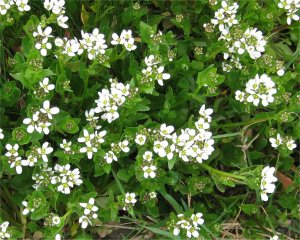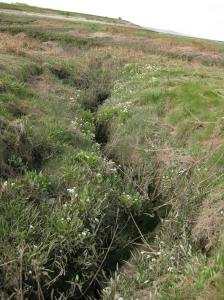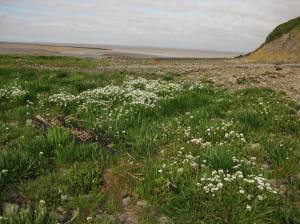Scurvy Grass is flowering all over the Pill. It occurs at the Mean High Water Mark and so is completely submerged at the highest (Spring) tides. It is a member of the Brassica (cabbage) family like the wild radish (see previous post).
It forms an effective marker to show how far the seawater penetrates, it lines the banks of the Land Yeo at the seaward end and also occurs along the channels that are found throughout the saltmarsh right up to the reed bed.
It is called Scurvy Grass because it has high concentrations of vitamin C in the leaves and sailors used to gather it to cure and prevent scurvy. It was also sold as a medicine on the streets of London before fresh fruit was widely available. There are several species, this one is probably Cochlearia anglica but the fruits will confirm that.
For years no-one knew that lack of vitamin C was the reason why sailors suffered lethargy, sores, opening of old wounds and bleeding gums – and eventual death. They had little in the way of fresh fruit and vegetables and once at sea for more than 6-8 weeks they fell ill.
It was hundreds of years before the link between lack of fresh produce and scurvy was established and even longer before anyone was prepared to anything effective about it. A few captains worked out their own solutions. Captain Parry who sailed several times to the Arctic and sometimes remained there for a year or more, grew mustard and cress and Captain Cook gave all the sailors sauerkraut (pickled cabbage). The sailors weren’t too keen on the sauerkraut but Captain Cook hit on the idea of restricting it to the officers – which made it suddenly popular!
So there is truth in ‘eating up your greens!’



